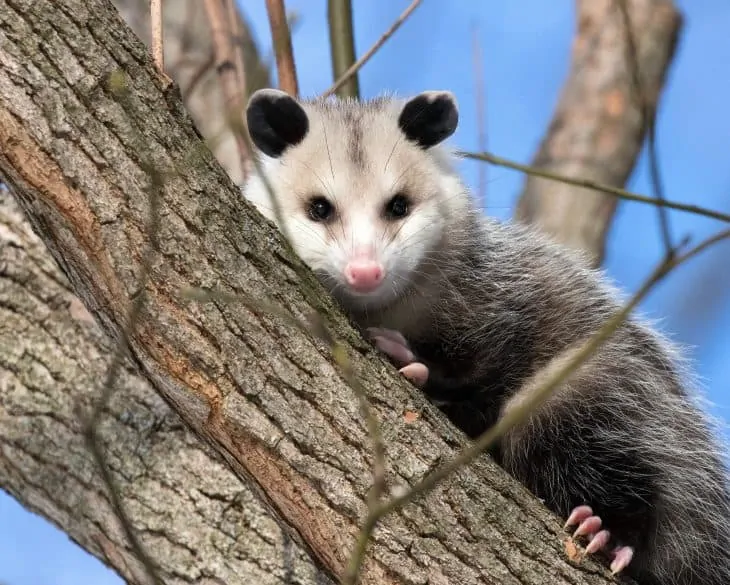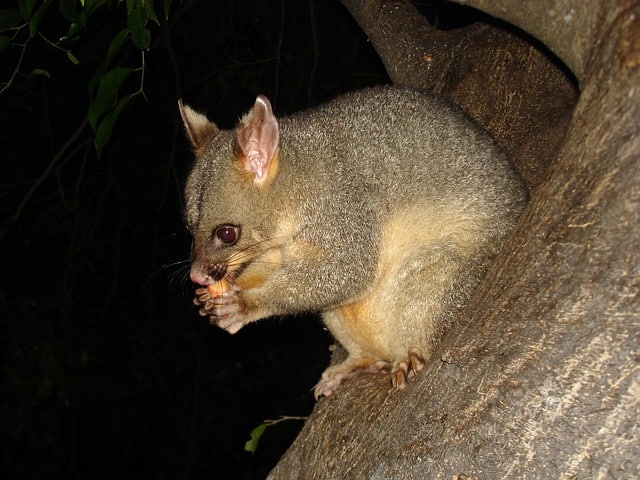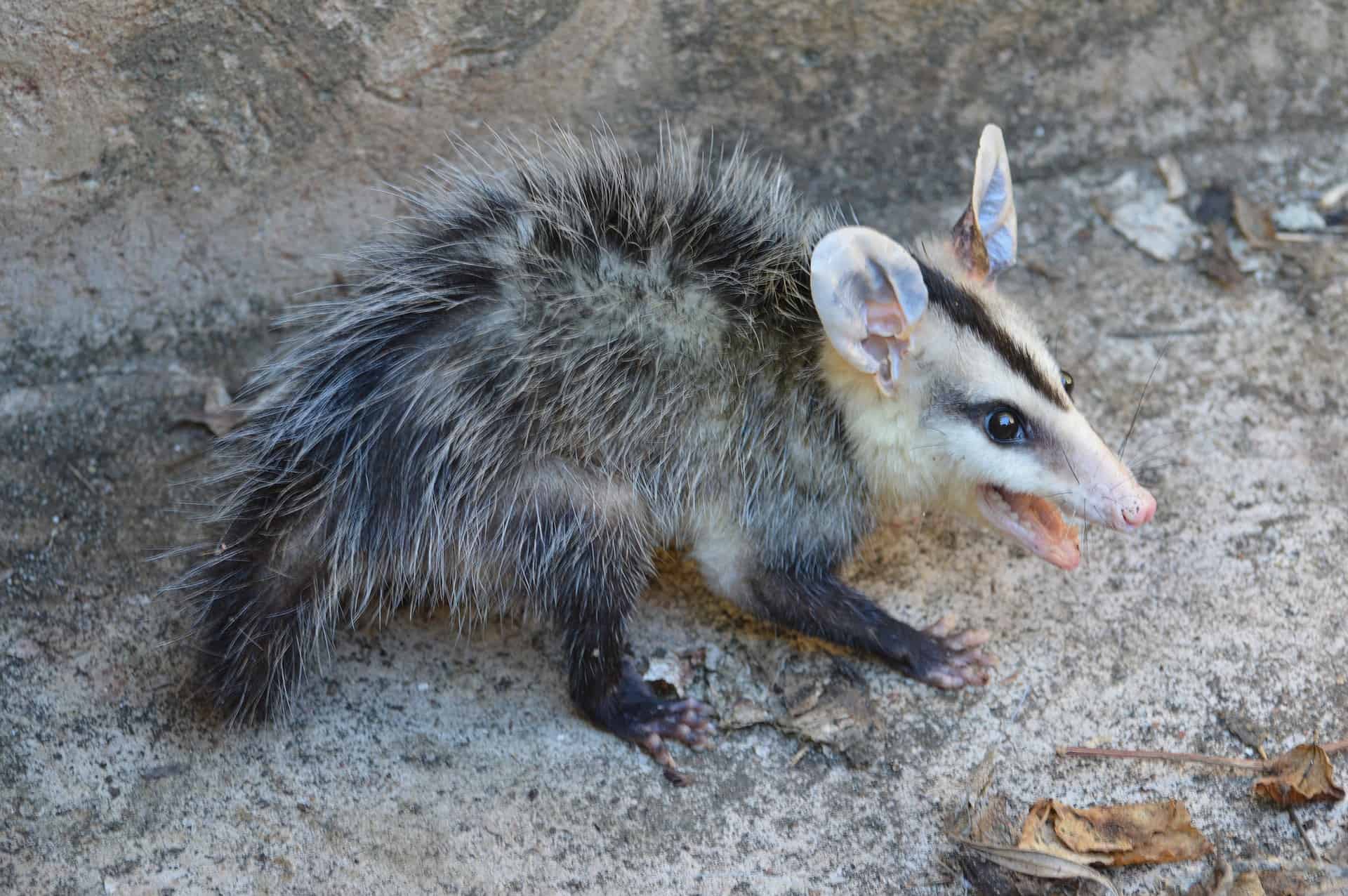
Opossums have a similar reputation with raccoons as pesky vermin that raid garbage bins. Because of this, they are creatures people frequently misunderstand. With interesting anatomies and behaviors, these marsupials native to the Americas certainly are nothing to brush off. Through these opossum facts, you’ll get to explore everything there is to know about these unexpectedly helpful animals.
- Opossums are not related to rats or any rodents.
- There are a total of about 103 species of opossums.
- The Virginia opossum has up to 50 teeth.
- A large male opossum from North America can weigh up to 20 times heavier than a female from the tropical regions.
- Weighing about 8.8 to 15.4 lbs (4–7 kg), the Thylophorops lorenzinii was the biggest opossum species of all time.
- Opossums are marsupials native to the Americas.
- A group of opossums is referred to as a passel.
- Opossums are mainly active during the night.
- They are mostly solitary animals, only meeting up to mate.
- Opossums are marsupials that belong to the order Didelphimorphia.
- Opossums rarely make their own burrows and generally tend to occupy abandoned burrows or already-existing structures.
- The extinct opossum genus Thylophorops included predatory opossums.
- Opossums are nomadic and rarely stay in the same spot. They tend to live in a more permanent residence in the winter or when weaning their young, however.
- They have large, round pupils adapted to see well in the dark.
- Opossums come in a wide variety of sizes; they tend to be smaller in the more tropical areas and larger in more temperate regions.
- Their name likely originated from the Powhatan language, and the borrowed word meant “white dog or dog-like beast”.
- Mark Twain listed the opossum as one of the parts of American cuisine.
- Their order name Didelphimorphia stems from the Greek term for “two wombs”.
- Male opossums, called jacks, are usually larger than the females, called jills.
- Female opossums usually raise the young by themselves.
The Virginia opossum is the only marsupial that can be found north of Mexico.
One of the most popular opossum facts is that they’re the only marsupials that live in Canada and the United States. In particular, the Virginia opossum (Didelphis virginiana) is the only marsupial species that lives in the wild north of Mexico. With its ancestors native to South America, it entered North America about 0.8 million years ago. From there, the range of this species moved steadily northwards – a trend that experts believe will continue to this day due to global warming.
Aside from being the first opossum species in North America, the Virginia opossum was the first to be called by the said term. Between 1607 and 1611, colonists John Smith and William Strachey first recorded the usage of opassom and aposoum at the early British colony in Jamestown, Virginia.
American opossums are different from Australasian possums.
Due to the similarity in their names, people often confuse opossums with possums. While they are distantly related, they have very distinct differences. The term opossum refers to marsupials of the order Didelphimorphia, native to the Americas. Meanwhile, possum refers to marsupials of the suborder Phalangeriformes, native to Australasia. When the Europeans first ventured into Australia, they encountered a species visually similar to the marsupials of America. Eventually, they described these species as “possums.”In the United States, people often call opossums by their shortened name ‘possums, which makes the opossum vs. possum distinction much more confusing. However, they are simply two different species.

A popular myth states that opossums breed using their noses.
When joeys reach the pouch, female opossums regularly lick their pouches and the joeys inside them. This behavior made people believe that opossums breed through their noses, placing the offspring from their noses to their pouch. While this may be a fun and imaginative concept to think about, opossums actually use their complex genitals to breed.
Opossums have a great resistance to snake venom.
Another impressive fact about opossums is that similar to honey badgers and ground squirrels, opossums developed a resistance to snake venom. Mostly observed in the large opossums (Didelphini), these animals are immune enough to regularly eat snakes as prey.
Some experts suggest that large opossums and pit vipers constantly compete with one another through adaptation. That said, opossums could have evolved their immunity to snake venom as a defense mechanism and eventually allowed them to eat these predatory snakes. Meanwhile, other scientists claim that it is a purely predatory adaptation that allows them to consume a new group of prey.
Opossums actually did not live alongside dinosaurs.
Many people believe that opossums are living fossils and existed alongside non-avian dinosaurs. While opossums did exist before humans, they did not actually live at the same time as your beloved Tyrannosaurus rex. However, researchers found that the oldest opossum fossils are only around 20 million years old.
They also found that the last common ancestor of all opossums existed around the boundary of the Oligocene and Miocene epochs about 23 million years ago. By that time, the dinosaurs were extinct already.
Opossums can consume up to 5,000 ticks per season.
One of the most interesting opossum facts is that they help curb the spread of the infectious Lyme disease by eating the parasites that carry the disease. Ticks are notorious for latching on animals and sucking their blood, sometimes transmitting the Borrelia bacteria that causes Lyme disease in animals like dogs and humans.
When ticks latch onto opossums, it’s basically a death sentence for the parasites. Along with squirrels, opossums are efficient tick-eaters. Although opossums don’t actively hunt tick nests to eat them, they eat more than 90% of the ticks that feed on their blood. On average, this amounts to around 5,000 ticks in a single season.
Opossums also eat a lot of common garden pests.
Aside from ticks, opossums also eat a host of common pests, such as snails, slugs, cockroaches, and even mice. Furthermore, they help clean the streets by scavenging the remains of roadkill — if they don’t end up as roadkill themselves, that is.
They have a resistance to rabies because of their low body temperatures.
While any mammal can possibly contract the virus, the odds of meeting an opossum that’s infected with rabies are extremely rare. This is because opossums typically have lower body temperatures than most placental mammals, which makes it difficult for the rabies virus to survive and replicate inside the opossum’s body.
Their body temperatures make them resistant to rabies infections, but infection is still possible. When attempting to handle a wild opossum, caution should still be exercised.
Opossums are susceptible to frostbite.
Because of their tropical origins, opossums are not too well-adapted to living in the heavy snow and harsh winters. Due to a lack of insulating fur, their bare ears, noses, tails, and toes are all susceptible to frostbite. In areas with colder winters, opossum populations might be lower.
It’s also not uncommon for an opossum to lose parts of its tail or ears due to frostbite. Despite this, Virginia opossums still thrive in areas as far north as Quebec and Ontario in Canada.
The Chacoan pygmy opossum is the smallest species of opossum.
Measuring just 1.7 in (68 mm) from head to body, the Chacoan pygmy opossum (Chacodelphys formosa) is the world’s smallest opossum species. First discovered in 1920 from Argentina, Scientists formerly classified this small species as a mouse opossum.
However, they found several aspects that make it distinct from other mouse opossums. Scientists then placed the Chacoan pygmy opossum in its own genus Chacodelphys in 2004, where it exists as the sole species.
Virginia opossums have some of the shortest gestation periods among mammals.
Humans carry their babies in their wombs for around nine stressful months before giving birth. Meanwhile, Virginia opossums give birth to their young after a brief period of just 11 to 13 days. This is one of the shortest gestation periods among all living mammals, second only to the stripe-faced dunnart’s 9.5 to 12 days.
A newborn opossum is only the size of a honey bee.
Because of their incredibly short gestation period, opossums give birth to severely underdeveloped babies. Also called joeys, they’re typically born smaller than honey bees. Opossums give birth to up to 20 young, at an average of 8 to 9 joeys. Sadly, many of the joeys die not long after birth, with only one in ten surviving until adulthood. Opossums typically do not invest too much in parenthood. Mothers will fiercely defend their young when they’re inside the pouch, but will largely ignore them once they’re outside.
They have 13 nipples.
After birth, like most marsupials, the blind and hairless honey bee-sized joeys must crawl their way into their mother’s pouch to drink milk and get warmth and protection. Scent glands within the pouch likely assist the newborns to locate the pouch. When the young reach the mother’s pouch, they then suckle on one of her teats until it’s time for weaning. Normally, opossums have 13 nipples, with 12 nipples arranged in a circle and one single nipple in the middle.
Young opossums detach from their mothers’ teats after about 70 to 125 days. Outside the pouch, joeys latch on to their mother’s back. After weaning, most young opossums live solitary lives. Some, however, may remain with their mothers for a while before they wander off. The young opossums reach sexual maturity within a year and typically breed at around 10 months of age.
Opossums don’t voluntarily play dead when threatened.
One of the most popular opossum facts is that they feign their death when they’re threatened. This is so well-known, in fact, that the idiom “playing possum” became a common synonym for pretending to be dead.
Playing possum, technically called thanatosis, is a unique but effective defense mechanism against predators. This strategy often confuses would-be predators or takes away their interest, as many predators only take an interest in live prey. Opossums also secrete a strong-smelling substance from their anuses to further throw off potential predators, such as foxes and owls.
While playing possum is an effective strategy, opossums don’t do it voluntarily. Instead, it’s an instinctual response to overwhelming stress, similar to fainting. Furthermore, it does not always play out well — opossums sometimes play dead in response to oncoming vehicles and end up as roadkill.
Opossums have opposable thumbs.
As semi-arboreal animals, opossums had to evolve with features that let them climb and navigate trees more easily. One of these adaptations is their clawless and opposable halluces or thumbs, which lets them grip onto tree branches.
They have prehensile tails.
Another adaptation to the semi-arboreal lifestyles of opossums are their strong, prehensile tails. Young opossums can hang on to tree branches using only their tails, while older opossums can also use their prehensile tails as an extra limb for climbing. Occasionally, possums can also use their tails to carry leaves and twigs for nesting.
They like grooming themselves.
Opossums have a reputation for being unsanitary and smelly, perhaps due to the foul smell they emit when they’re playing dead. In reality, opossums like grooming themselves and keeping themselves largely odorless. To keep themselves clean, they would either lick their own bodies or scrub their fur with their paws. Furthermore, opossums don’t sweat, so they have to use their saliva to cool themselves.
Like most marsupials, they have a complex reproductive system.
Most marsupials have complex genitalia, and opossums are no exception. For one, male opossums have forked penises with two heads. Females, on the other hand, have two uteri and three vaginas. The two lateral vaginas on each side of the opossum’s body serve as passageways for sperm, while the medial vagina is where the joeys pass through during birth. How’s that for awesome opossum facts?
The water opossum is the most aquatic marsupial.
Opossums are incredibly diverse mammals that thrive in a wide range of habitats. Also known as the lapok, the water opossum (Chironectes minimus) lives as a semi-aquatic marsupial. Although lutrine opossums also live semi-aquatic lifestyles, water opossums are the most aquatic marsupials in the world.
Male water opossums also have pouches.
Aside from being the most aquatic marsupial, the water opossum also exhibits another trait that sets it apart from other marsupials. The pouches of most marsupials are exclusive to the females for the purpose of carrying their young, but male water opossums also have pouches. These pouches protect their genitals from being caught in aquatic plants, while also helping the opossums become more streamlined.
Virginia opossums have small brains.
One of the most surprising opossum facts is that they successfully thrive in the wild despite having relatively small brains. Around five times smaller than the brains of raccoons, Virginia opossums have a very low brain-to-body ratio. Truly one of the surprising opossum facts you should remember.
They have a fairly short lifespan.
Opossums are animals with fairly short lives, with lifespans of only around one to two years in the wild. Even in captivity, they live short lives of up to four years. This is because opossums have an extremely fast aging process, making them live fast and die young.
Opossums have relatively poor eyesight.
Despite having good night vision, these nocturnal marsupials have a relatively poor general eyesight and color vision. To make up for it, opossums mostly get around through the use of their sensitive whiskers and keen sense of smell.
Opossums do not hibernate, but they move slower during the winter.
Although opossums now thrive in areas with cold winters, they don’t hibernate like bears during the winter. However, to conserve their energy, they tend to stay in one place and greatly reduce their physical activity during the colder months. Some opossums also exhibit torpor, which is similar to hibernation but lasts only for a short period of time.
They spread to the US West Coast because of the Great Depression.
While Virginia opossums have successful populations throughout the Pacific coast, they weren’t originally native to the US West Coast. Instead, they only got introduced into the region when humans brought opossums with them as food during the Great Depression. Now that’s one for dark opossum facts.
Common opossums can only be hunted in specific times of the year.
One of the less-adorable opossum facts is that humans sometimes hunt them as food. The common possum, southern opossum, or manicou (Didelphis marsupialis) is a popular food item in the Caribbean. Due to overhunting, it is not as common as it previously was. To protect the species from further losing their numbers, people can only hunt them in specific times of the year.

Former US President William Howard Taft loved eating opossums.
During the time of 27th US President William Howard Taft’s office, eating opossums was a commonplace occurrence in their culture. He was also a big fan of eating these marsupials, and would even eat a huge opossum alongside his Thanksgiving turkey.
The plush opossum toy Billy Possum attempted to compete with the teddy bear.
After the teddy bear rose to popularity from Theodore Roosevelt’s presidency, toy manufacturers worried that the hype would dwindle after he stepped out of the office. To replace the teddy bear, the manufacturers attempted to popularize another toy: Billy Possum, after William Howard Taft’s knack for eating opossums.
However, the stuffed opossum toy largely had a rather poor public perception, however. Needless to say, Billy Possum didn’t become as popular as the now-ubiquitous teddy bear.
The tail of the elegant fat-tailed mouse opossum thickens due to fat deposits.
Known for its thick and hairless tail, the elegant fat-tailed mouse opossum (Thylamys elegans) is a crepuscular opossum native to central Chile. Its tail thickens because of the accumulation of fat deposits, giving the opossum its namesake.
Scientists often use the gray short-tailed opossum for laboratory experiments.
The gray short-tailed opossum (Monodelphis domestica) is a small South American opossum that scientists commonly use as laboratory animals. Gray short-tailed opossums are important research models for the study of mammalian immune systems and development, as well as the study of marsupials. These small opossums lack pouches but are still classified as marsupials because of their genetic origin.
Was this page helpful?
Our commitment to delivering trustworthy and engaging content is at the heart of what we do. Each fact on our site is contributed by real users like you, bringing a wealth of diverse insights and information. To ensure the highest standards of accuracy and reliability, our dedicated editors meticulously review each submission. This process guarantees that the facts we share are not only fascinating but also credible. Trust in our commitment to quality and authenticity as you explore and learn with us.
